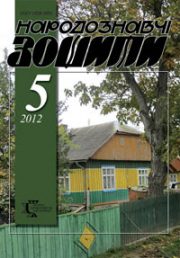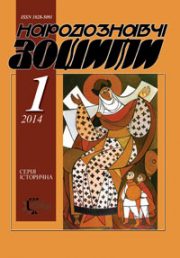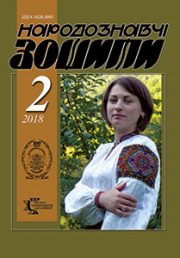The Ethnology Notebooks. 2017, 4 (136), 971–976
UDK 72.012(477.73).
DOI https://doi.org/10.15407/nz2017.04.971
SOME ASPECTS OF DESIGN FORMING ON THE EXAMPLE OF ARCHITECTURE OF MYKOLAIV
Sapak Natalia Victorivna — a candidate of study
of art professor, associate professor of department
of design of Separated subdivision “Mykolaiv branch
of the Kyiv national university of culture andarts”.
street of Decembrists, 17, 54001, Mykolaiv, Ukraine.
Abstract. The sources of architectural design in Mykolaiv in ХІХ — at the beginning of ХХ century on the example of artistic metal, artistic screw-thread and brick building has been researched. The grounds of development of these types of art and their stylish and technological features have been defined. Connection between craftmen’s activity and becoming of design professional training has been underlined.
Keywords: metallic-plastic arts, screw-thread, brick building, artistic education, design.
Received 6.07.2017
REFERENCES
Bon’kovs’ka, S. M. (2003). Koval’stvo na Ukraini (XIX pochatok XX st.).Kyiv: Naukova dumka [in Ukrainian].
Krjuchkov, Ju. S. (2008). Arhitektura starogo Nikolaeva. Nikolaev: Vozmozhnosti Kimmerii [in Russian].
Kukhar-Onyshko, N. O. (2001). Arkhitektura Mykolaieva (kinets’ XVIII pochatok XX stolit’). Mykolaiv [in Ukrainian].
Malyna, V. (2006). Narodne mystetstvo Pivdnia Ukrainy. Kinets’ XIX pochatok XX st. Mykolaiv [in Ukrainian].
Mogilevskij, V. Ju. (1990). Hudozhestvennyj metall v arhitekture Kieva serediny XVII nachala XX st.: avtoreferat dis. na soisk. uch. st. kand. iskusstvovedenija. Moskva [in Russian].
Sapak, N. V. (2003). Khudozhnia osvita na Pivdni Ukrainy v pershij tretyni XX stolittia. Mystetstvoznavstvo Ukrainy: Zbirnyk nauk. prats’. Kyiv: SPD Kravchuk V. K. Vyp. 3. S. 331–338 [in Ukrainian].
Sapak, N. V. (2011). Deiaki aspekty rozvytku khudozhn’oho metalu XIX pochatku XX stolittia na prykladi arkhitektury mista Mykolaieva. Visnyk Kharkivs’koi derzhavnoi akademii dyzajnu i mystetstv: Zbirnyk nauk. prats’. Kharkiv: KhDADM. 4. S. 144–147 [in Ukrainian].
Timofiienko, V. I. (1994). Bramy, ohorozhi pivdennykh mist. Kyiv [in Ukrainian].







